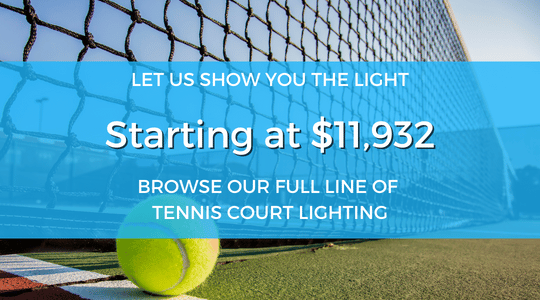Shop Our Catalog For: Sports Field & Athletic Lighting

How Professionals Put Together Tennis Court Lighting
In general, professionals will look to retrofit LEDs over existing “cans,” which is another term for fixtures. These cans are mounted on poles 20 to 30 feet high, and the height of the pole will affect what fixture model the design crew will use. If the court is newly built, an experienced designer can install a new set of poles and LED fixtures.
There a couple goals when setting up tennis court lighting. They include:
- Providing enough lighting in the total playing area (TPA). This is the obvious one, as the system has to be bright enough to allow players to continue competing into the night. It also has to be bright enough to allow spectators to follow the action. The TPA refers to the area encompassing the entire area of the court, up to a foot away from its perimeter. The designer’s objective is to ensure that this area is hit with enough light, measured in lumens or foot candles, by the installed fixtures.
- Ensuring that the emitted light is comfortable and renders color properly. Some fixtures, like pressurized sodium lights, emit enough illumination, but the light they emit washes out colors and appear dark in comparison. This can make people feel uneasy when around them. Metal halides have been a preferred option for so long because they sit closer to natural white and render color reasonably well. LEDs, though, are even better in this regard, and offer superior color rendering and comfort.
Lighting designers rely on sophisticated photometric modeling software to map out where fixtures should be placed. During photometric analysis, the court is laid out on a grid, usually segmented in increments of a few feet. As fixtures are added and moved in the model, the software calculates the lumen or foot candle level in each space, giving designers a clear picture of how the lights will perform following installation. For this reason, photometric analysis is strongly recommended for any large scale lighting project, and not just tennis court projects.
That said, a standard lighting package for a 60×120 court is eight cans, evenly spaced and with four on each side. With modern LED luminaries, this will produce even, bright illumination that does not emit considerable glare and does not leave any shadows behind.
This eight can arrangement has long been the standard, and it has been used with metal halides for a long time. So, why should an arena consider a move to LEDs? The case is overwhelmingly in favor of LED fixtures, and includes:
- Improved Efficiency – When dealing with high powered fixtures, there is always going to be some lumen loss due to the drivers, ballasts and secondary optics. This means that while metal halides may appear to be nearly as efficient as LEDs, this is not the case when factoring in how much work has to be done to direct the light. Metal halides, for example, require inefficient ballasts and heavy reflectors to angle emitted light, as metal halide fixtures emit light in all directions. LEDs, though, don’t need this extra equipment, as LEDs are easily directed. In the end, this makes LEDs close to twice as efficient as metal halides, a difference that will save an arena thousands of dollars every year in energy costs.
- Extended Longevity – LED luminaries are engineered for maximum durability, and LED technology itself is inherently durable, as it produces little radiant heat. LED luminaries are contained in an airtight chamber that is pressed right up against several inches of tough, optical glass. This fixture design keeps dust, moisture and other particulates away from the luminaire. Put it all together, and it’s common for LED fixtures to last up to 10 times longer than metal halides, and LEDs hold onto their output level much better than metal halides. Less maintenance equals lower maintenance costs.
- Unmatched Controllability – LED fixtures can be controlled much more precisely than metal halides, which take a while to warm up. Voltage also has to be altered when dimming metal halides, which takes significant effort. LEDs, though, can be switched on and off instantaneously, can be easily dimmed, and can even be controlled from a smartphone. LEDs are designed with modern technology in mind, giving tennis court owners extra options in how they operate.
Tennis courts don’t have to be shut down when the sun goes down. With high quality LED fixtures, the owner can keep the lights running and the play continuing for a fraction of the operating cost of metal halides.







